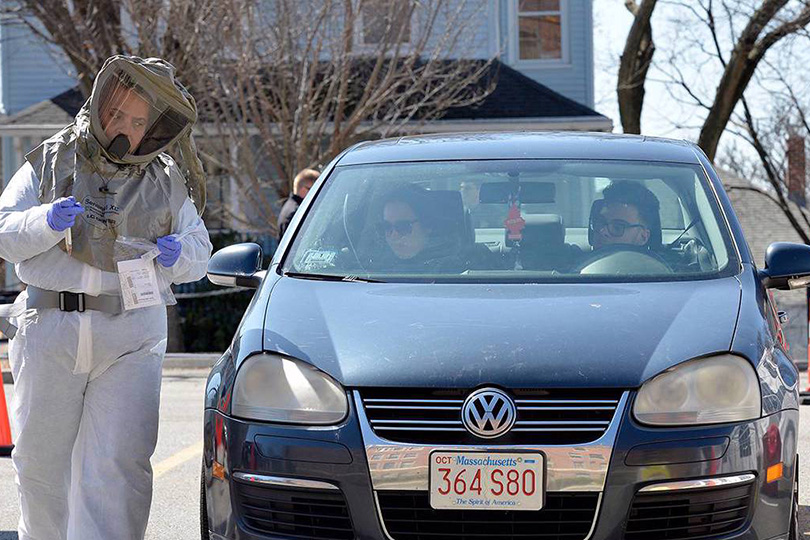Just two months ago, most people believed that random mass death no longer stalked the Earth. Reconciling ourselves with the reality that it does clarifies much, including how to resist the current onslaught, how to fortify ourselves against the darker days that still await, and how to reopen the economy responsibly.
We live now in the post-virus world. For the United States, passage into this world came suddenly, less than a month ago. The world as we knew it before the arrival of COVID-19 has gone. It is never coming back.
Once you reconcile yourself with this reality, many things become clearer, including how to resist the current onslaught, how to fortify ourselves against the darker days that still await, and how to reopen the economy responsibly. With the right understanding, we can rebuild appropriately, with greater resilience and more fairness.
At the start of 2020, we believed random mass death did not stalk the Earth. For most of human history, infectious disease was a constant threat, and the struggle against it was an essential element of human civilization. By the mid-nineteenth century, science began to gain the upper hand against afflictions such as cholera.
In the early 1900s, Europeans learned how to limit the damage from malaria and yellow fever, at least for themselves. Penicillin and streptomycin were deployed in force during the 1940s. Childhood vaccinations for smallpox, measles, mumps, rubella, and chickenpox soon followed.
Over two centuries, roughly from the invention of inoculation against smallpox to its eradication, science rose to dominate the environment. To be sure, new diseases emerged – beginning in the 1980s, for example, when HIV/AIDS devastated some communities and countries. But the prevailing view was that such health emergencies – while needing resources and demanding attention – were not central to the organization of our economies, our societies, and our lives.
The global impact of COVID-19 makes that view obsolete. Random mass death is back, and this reality will now dominate everything, for two reasons.
First, and more generally, this is not the first coronavirus, and it is one of several lethal variants to emerge since the turn of the millennium, including severe acute respiratory syndrome (SARS) and Middle East respiratory syndrome (MERS). There is no reason to think it will be the last.
Second, this particular coronavirus derives its lethal power from its specific profile: it is highly infectious and can be transmitted even by asymptomatic people. And, while many people who contract COVID-19 will suffer only a mild form, it appears most likely to kill older people and those with underlying health conditions, such as hypertension, diabetes, and obesity.
But why would any future coronavirus necessarily have a similar profile? Other coronaviruses – from those that cause the common cold to the deadly ones that cause SARS and MERS – do not. It is entirely plausible, given the weak state of our scientific understanding, that a future coronavirus could profile in a different way – for example, proving more lethal to young people than to the old. Or perhaps it will target our children.
Once you have had that thought, it is not possible to believe that we can return to the pre-virus world. Everything we do, all of our investments, and the way we organize ourselves will be influenced by consideration of whether we are protected from COVID-19 and its successors or made more vulnerable to them.
With this understanding, several points become clear, or even – at a difficult and tragic time – potentially reassuring.
The US and Europe have obviously massively underinvested in preparation – including the relevant science and how to apply it – and COVID-19 will likely prove devastating in the West. But the reason is not so much a lack of available technology. After all, China eventually managed to contain its outbreak – after a two-month lockdown – while Taiwan and Singapore never fell behind, and South Korea pulled off an amazing escape at what appeared to be a very dangerous moment.
It is not our lack of technology that has left the West vulnerable; rather, it is the interaction of COVID-19 with our social structure and health-care provision. In the US, in particular, the virus exploits an unequal society and a fragmented health system.
We have more than enough weapons to fight back, but too many of them are pointed in the wrong direction – designed with precision for previous and much smaller crises, such as hurricanes. Powerful organizations, with deep capabilities, are held back by leaders who fail: to collect the necessary intelligence, to coordinate sufficiently, or even to use data in a coherent manner to make decisions.1
This phase will not last long. Soon, we will learn how to fight back and with full force. We will get ahead of COVID-19. Then we can start to rebuild a more resilient set of information, decision-making, and health-care systems. As part of that, we must make an unprecedented commitment to develop and deploy every scientific and organizational idea that increases the survival chances for our children and our neighbors’ children.
Eventually, we will prevail in the post-virus world. But it will be a long haul. The best way to shorten it is to recognize that a return to “normal” is not an option.







Comments